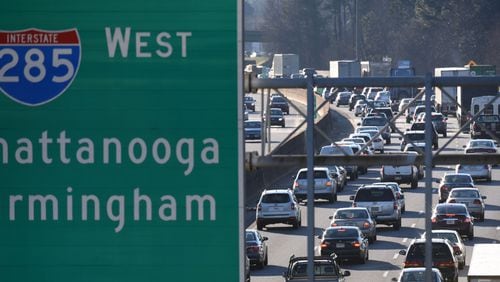Existing toll lanes
Continuing coverage of Georgia’s shift toward toll lanes:
Gov. Nathan Deal unveils 10-year, $10 billion transportation plan
http://www.myajc.com/news/news/local/gov-nathan-deal-unveils-10-year-10-billion-transpo/np35c/
Anatomy of a Toll Lane (graphic)
http://www.myajc.com/news/toll-anatomy/
More toll roads in your future
http://www.myajc.com/news/news/local/ask-not-for-whom-the-road-tolls-it-tolls-for-thee/nm6PY/
Drivers on I-75 must decide whether new toll lanes are worth it
http://www.myajc.com/news/news/traffic/priced-to-move-drivers-must-decide-to-pay-or-not/nmz2R/
Giant toll lane project ramps up — and up — on I-75 and I-575 in Cobb and Cherokee
http://www.myajc.com/news/news/local/giant-toll-lane-project-ramps-up-and-up-on-i-75-in/nmw4P/
Reversible toll lanes, what could go wrong?
http://commuting.blog.ajc.com/2015/07/13/reversible-toll-lanes-how-will-that-work/
One of the most ambitious transportation plans in state history — including a 52-mile network of optional toll lanes around metro Atlanta — will slow you down before it speeds you up.
Unveiled last week by Gov. Nathan Deal, the $10 billion, 10-year plan includes hundreds of bridge and road projects large and small aimed, in part, on easing traffic congestion for metro commuters. But the plan will actually take longer to complete than 10 years and cost more than $10 billion. In the meantime, you'll be slogging through years of road construction on I-285, Ga. 400 and other metro interstates.
“I do think realistically there is going to be a lot of work going on in the metro region,” Georgia Department of Transportation Commissioner Russell McMurry said in an exclusive interview with The Atlanta Journal-Constitution. “Not tomorrow or next year, but three or four years from now.”
The inconvenience aside, the toll-lane network is state leaders' response to help deal with the region's most intractable problem: traffic.
“This is the first implementation I have seen of this magnitude in improving our infrastructure in Georgia that I can remember,” Deal said at a press conference Tuesday.
The massive plan includes adding 52 miles of new toll lanes to I-285 and Ga. 400; rebuilding the I-20 interchanges on the east and west sides of I-285; and widening 17 miles of I-85 in Gwinnett and Jackson counties. It also aims to improve trucking corridors near the Savannah port and on I-75, and includes billions of dollars in bridge, repaving and maintenance work.
While the first major projects will probably begin to roll out in about three or four years, they’ll be staggered. So all of the improvements won’t be completed until 2030.
Doubling down on tolls
The big ticket undertakings slated for metro Atlanta — most notably, nearly doubling the size of the region’s toll lane network to 120 miles — follow the lead of other urban areas.
Cities like Los Angeles, San Francisco, Houston, Dallas and Miami are also moving to expand their toll lane networks, said Matt Click, the national director of priced managed lanes for HNTB. Los Angeles and San Francisco both plan to build more than 500 miles of toll lanes.
Express toll lanes have become an attractive option for cities because they provide a reliable trip time in traffic-clogged zones, and their construction costs can be financed in part with future toll revenues. Plus, Xpress buses can travel in them for free, which in theory will attract more transit ridership.
McMurry said he expects drivers in the regular lanes and the tolled lanes to have improved trip times, since they will add interstate capacity. Traffic projections for 30 miles of new toll lanes under construction on I-75 and I-575 in Cobb and Cherokee counties show commuters in the regular lanes who are traveling from one end to the other will shave a few minutes off of their trip time. Drivers in the toll lane will see their commute times cut by nearly two-thirds.
Although toll lanes have been operating on I-85 since 2011 and are seeing record use there, they remain controversial among metro Atlanta drivers.
Attorney Rusty Fleming embraces the idea of putting tolls on Ga. 400. He said his commute from Cumming to Midtown can balloon from 35 minutes with no traffic to an hour and 15 minutes during rush hour.
“I wish they would put the toll booths (on Ga. 400) back up and double the price,” Fleming said. “Traffic is so much worse now that they took down the toll plaza, it’s ridiculous.”
Adam Tucker, a business analyst who lives near Perimeter Center, doesn’t agree with the use of toll lanes.
“Where does that money go? To pay for the toll lane? To build more lanes?” Tucker said. “To me it just seems like a money grab.”
Some state leaders have criticized the plan’s lack of support for public transit in favor of road-heavy solutions to congestion. (A majority of the money used for transportation projects comes from the state’s gas tax, which Georgia law prohibits from being spent on anything but roads and bridges.)
Lawmakers last year provided only a one-time, $75 million set-aside for transit that had to be split up among transit providers statewide. Democrats have called that “a pittance.”
MARTA needs far more — about $8 billion — to fund major expansion projects on its priority list. MARTA leaders plan to lobby for a referendum this year to let county voters in Fulton and DeKalb decide whether to pay higher local sales taxes to fund the projects.
The 2013 Statewide Strategic Transportation Plan stated in the event of receiving new funding, a priority for metro Atlanta transportation planning should be building a bus rapid transit network, said Brian Gist, a lawyer with the Southern Environmental Law Center.
“If we’re going to do plans, we should follow through with the recommendations,” Gist said.
Sticker shock
The ambitious slate of projects Deal unveiled this week was made possible, he said, by a sweeping transportation funding bill that state lawmakers passed last year. The legislation (House Bill 170) included a gas tax increase as well as a mix of new fees.
Revenues from the bill are expected to average out to about $1 billion a year over the next 10 years — effectively doubling the state’s annual budget for transportation projects. Over just the next 18 months, the proceeds will allow GDOT to begin resurfacing over 2,500 miles of state routes and interstates, replacing 118 bridges, rehabilitating 300 bridges, widening 36 roads, and upgrading 109 intersections.
Around the state, Deal’s plan involves key investments in the freight network designed to speed the flow of goods. They include adding truck-only lanes on I-75 between Macon and McDonough, reconstructing the interchange of I-95 and I-16 near Savannah and the widening of I-16.
But to execute the big-ticket projects, transportation officials say it will cost an additional $14 billion in excess of the $10 billion Deal referred to in his 10-year plan. The state will have to incur debt to accomplish the new toll lanes and interchanges — loans that taxpayers will likely repay over a decade or more.
For example, with the most expensive of the projects, the $5.9 billion addition of two new toll lanes in each direction of I-285 between I-75 and I-85, the state will probably enter a financing agreement with a private partner to repay construction costs over 20 years.
Otherwise the state could never afford to expand the Perimeter, because the cost for adding lanes to that small wedge alone is equivalent to three times GDOT’s annual budget for projects statewide.
Years of roadwork ahead
For now, get used to the sight of orange barrels, traffic cones and bulldozers.
The construction schedule for each of the projects in the governor’s plan is still to be determined, though all projects are slated to be advertised for bid within 10 years. The last project will probably open to traffic by 2030, GDOT Commissioner McMurry told the AJC.
The expansions of I-85 and I-16 are simpler to design and construct than, say, building new toll lanes or rebuilding interchanges, and will likely go first. All the projects will be spaced out to minimize the impact on budgets and traffic.
But commuters can expect probably three to four years of construction along the top-end of I-285, about three years of construction on the I-20 interchanges, and about three years of roadwork along Ga. 400, McMurry said.
Anne Bristol Flesh, a recruiting consultant from Vinings, welcomes the addition of toll lanes along I-285 and would use them to avoid traffic. But she dreads the road work.
“It is hard, because we are all tired of construction,” she said. “It is a Catch-22. They just need to do it the best way they can to mitigate the pain.”
About the Author






